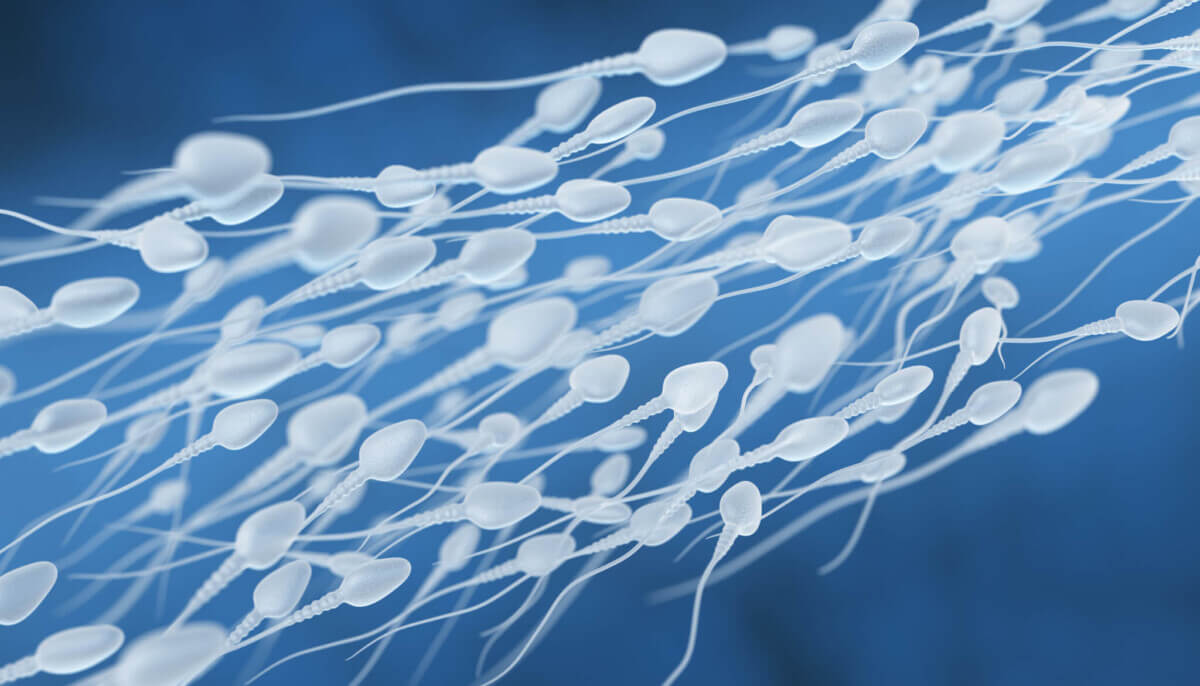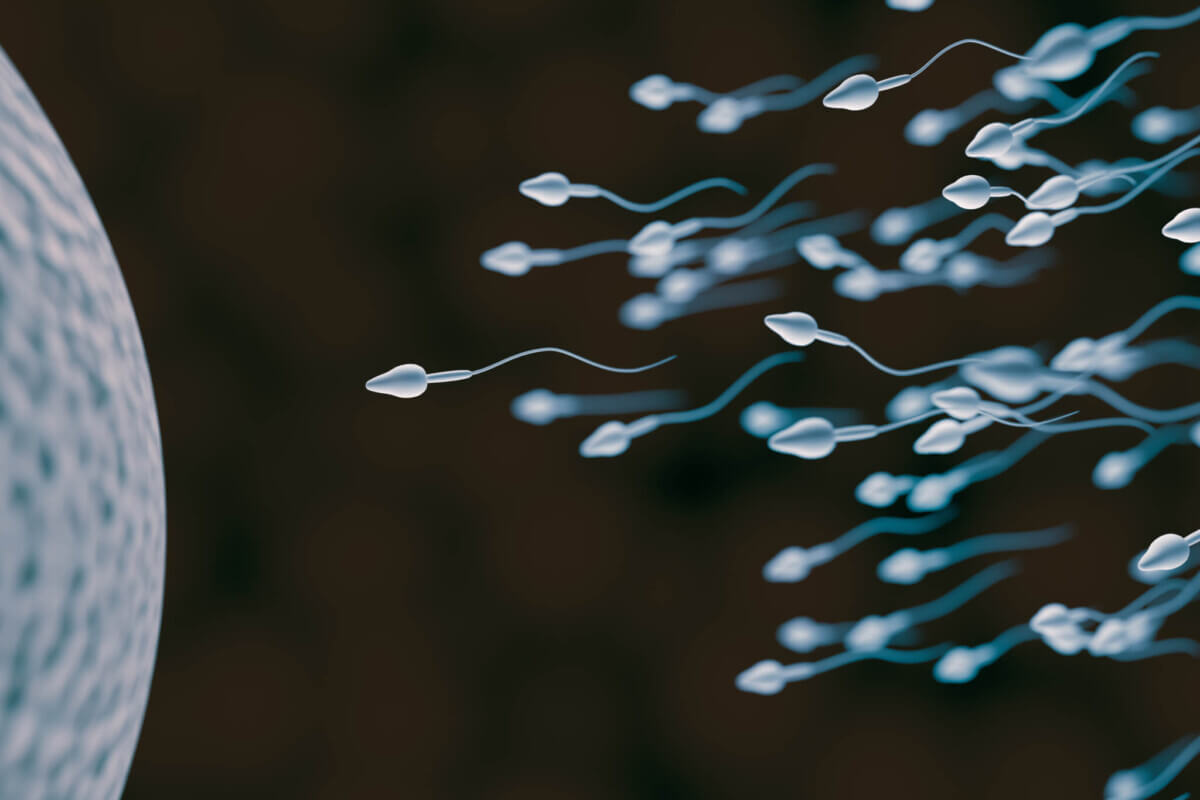(Credit: StoryTime Studio on Shutterstock)
In A Nutshell
- A new study finds up to 5% of sperm in older men carry disease-linked mutations.
- Sperm mutation rates rise with age due to competition among stem cells in the testes.
- Forty genes under “positive selection” drive many of these changes.
- Paternal age adds genetic risk, but overall probabilities remain low for most families.
HINXTON, England — At first glance, the news sounds reassuring: sperm cells accumulate genetic mutations eight times slower than blood cells, making them among the most protected cells in the male body. But that’s where the good news ends. Research reveals that this protection has a critical weakness, one that causes disease-causing mutations to spread through a man’s sperm supply as he ages.
The problem isn’t the mutation rate itself, but rather a form of cellular competition that gives certain harmful mutations a survival advantage. By analyzing sperm from 57 men ranging from their mid-20s to mid-70s, scientists at the Wellcome Sanger Institute found that 3 to 5% of sperm from middle-aged and older men carry mutations linked to developmental disorders or childhood cancers. The discovery adds a new dimension to discussions about reproductive age, one that has received far less attention than maternal age effects despite carrying its own distinct risks.
Identifying Gene Mutations In Sperm
When couples consider starting a family later in life, the conversation about age-related risks typically focuses on the mother. Maternal age has long been linked to chromosomal abnormalities like Down syndrome, with well-established guidelines for genetic counseling. But this sweeping new study suggests that a father’s age matters far more than previously thought, and for entirely different reasons than maternal age effects.
Researchers analyzed sperm samples from men between ages 24 and 75, using a cutting-edge sequencing technology called NanoSeq that can detect individual mutations with unprecedented accuracy. They also examined blood samples from many of the same men to compare mutation rates across different tissues.

The results revealed something unexpected. Sperm cells accumulate genetic mutations remarkably slowly, about eight times slower than blood cells. A man’s sperm gain roughly 1.67 new mutations per year, while his blood cells rack up nearly 20 mutations annually.
The male body appears to protect the genetic material destined for the next generation. Among all the cell types scientists have studied, the stem cells that produce sperm have the lowest mutation rate measured.
But that protection has a loophole.
When Bad Mutations Win the Competition
Throughout a man’s adult life, stem cells in his testicles divide to produce fresh sperm, about 150 to 275 million per day. These stem cells compete with one another for space and resources along the tubules where sperm production occurs.
Occasionally, a mutation arises that gives one stem cell line an edge over its neighbors. That cell and its descendants proliferate more successfully, gradually taking over more territory. Over months and years, this means an increasing fraction of a man’s sperm carries that particular mutation.
Scientists call this process “positive selection” because the mutation provides a competitive advantage, at least for the sperm-producing cells themselves. The problem is that many of these same mutations cause serious health problems when passed to children.
The research team identified 40 genes where mutations confer this competitive advantage. Previous work had found only 13 such genes. What makes the new discoveries particularly notable is their diversity. Earlier studies had focused on activating mutations in a cellular signaling pathway called RAS-MAPK. But the newly identified genes involve loss-of-function mutations spread across multiple biological systems: genes controlling cell communication, genes that modify DNA packaging, and genes that process RNA molecules.
Most of these 40 genes are linked to developmental disorders or childhood cancers. When children inherit mutations in these genes, they may develop conditions like Noonan syndrome, Myhre syndrome, or cancer predisposition syndromes. Some mutations affect growth and facial features. Others impact heart development or cognitive function.
The Mathematics of Risk
So what does this mean in practical terms?
The researchers calculated that in men around age 30, approximately 2% of sperm carry a mutation likely to cause disease if it leads to a pregnancy. By age 70, that figure climbs to around 4.5%.
These percentages reflect averages across thousands of possible mutations in dozens of genes. Individual mutations remain rare. The study found an average of 18 distinct disease-associated variants per person, with 99% appearing in only a single sperm cell out of thousands analyzed. The risk comes from the aggregate: lots of different rare mutations rather than any single common one.
Six genes account for more than 20% of the total disease burden from selected mutations. These include KDM5B, MIB1, SMAD6, PRRC2A, NF1, and PTPN11. Each has been linked to specific disorders, and mutations in these genes appear with surprising frequency in older men’s sperm due to the selection process.
About one-third of the disease-causing mutations found in sperm arise from this active selection favoring harmful variants. Another third accumulate simply from the normal copying errors that occur over time. The final third likely come from additional genes under selection that haven’t been identified yet.

A Puzzle Solved
The research also solves a mystery that has nagged at geneticists. Four genes — SMAD6, MIB1, LZTR1, and SSX1 — show up more often in healthy populations than expected given that mutations in these genes can cause problems. If natural selection removes harmful variants over generations, why do these persist?
The answer, it turns out, is that they’re constantly being replenished. Positive selection during sperm production keeps pumping these mutations into each new generation faster than natural selection can eliminate them. It’s like trying to bail water from a boat while someone keeps pouring more in.
What This Means for Families
Unlike the chromosomal abnormalities linked to maternal age, which can be screened for through established prenatal tests, paternal age-related mutations present a different challenge. They’re individually rare but collectively common. Each man’s sperm contains a unique constellation of low-frequency mutations spread across many genes.
This pattern makes conventional screening approaches difficult. Testing for all possible mutations would be prohibitively complex and expensive. The mutations are so rare that most wouldn’t be detected even with sophisticated testing.
The research team found no link between mutation burden and factors like body weight, smoking, or alcohol consumption in this study group. The male reproductive system appears somewhat shielded from lifestyle exposures that affect mutation rates in other tissues. However, the study didn’t include men who’d undergone chemotherapy or had inherited DNA repair defects, both known to dramatically increase mutation rates in sperm.
It’s also worth noting that many mutations present in sperm may never result in a live birth. Some might prevent fertilization altogether. Others could lead to early pregnancy loss. The study couldn’t measure these outcomes, so the real-world impact might be lower than the 3-5% figure suggests.
Additionally, typical paternal age at conception tends to be younger than the men in this study, who averaged 53 years old. Most fathers have children in their 20s, 30s, or early 40s, when mutation burdens are correspondingly lower.
A Shift in Perspective
For decades, medical advice about age and reproduction has centered on maternal factors. Women know their fertility declines with age. They understand the risks of chromosomal abnormalities increase after 35. Prenatal care routinely addresses these concerns.
But this research adds an important dimension to the conversation. Fathers contribute their own age-related risks through a completely different mechanism, one that operates continuously throughout adult life and affects a broad range of genes.
As more couples delay having children, understanding both maternal and paternal contributions to genetic risk becomes increasingly relevant. The average age of first-time fathers has been rising in many countries for decades.
The scientific community will need to grapple with how to translate these findings into practical guidance. Should reproductive counseling address paternal age more directly? Are there circumstances where genetic screening of prospective fathers makes sense? How do we communicate risks that are real but probabilistic, serious but not deterministic?
Those questions remain open. For now, the research primarily expands our understanding of how genetic variation enters human populations and why certain harmful mutations persist despite natural selection’s efforts to remove them.
“There’s a common assumption that because the germline has a low mutation rate, it is well protected,” said Dr. Raheleh Rahbari, senior author and Group Leader at the Wellcome Sanger Institute, in a statement. “But in reality, the male germline is a dynamic environment where natural selection can favor harmful mutations, sometimes with consequences for the next generation.”
The invisible competition among sperm-producing cells has been operating in men for as long as our species has existed. We’re only now developing tools precise enough to see it clearly, and to understand what it means for the next generation.
Disclaimer: This article is for general information only and not medical advice. Individuals with concerns about reproductive age or genetics should consult a qualified healthcare provider.
Paper Summary
Methodology
The researchers used NanoSeq, an error-corrected duplex DNA sequencing method, to analyze mutations in sperm and blood samples. The cohort included 81 bulk sperm samples from 57 men aged 24-75 years and 119 blood samples from 63 men aged 22-83 years, all from the TwinsUK registry. The study employed three sequencing approaches: whole-genome NanoSeq for mutation burden and signature analysis, targeted NanoSeq covering 263 cancer and developmental disorder genes, and whole-exome NanoSeq covering approximately 18,800 genes. The duplex sequencing method reads both strands of DNA molecules to achieve single-molecule resolution with an error rate below 5 in 1 billion base pairs. Inherited germline variants were excluded using matched blood samples. The team used a modified algorithm to detect positive selection by calculating the ratio of mutations that change protein sequences to those that don’t, accounting for sequencing coverage, DNA methylation levels in testis tissue, and the surrounding genetic context.
Results
Sperm accumulated mutations at 1.67 substitutions per year per haploid genome, approximately eight times slower than blood cells at 19.9 substitutions per year per diploid genome. Two mutational signatures drove this accumulation: SBS1 and SBS5, both associated with aging. The exome-wide analysis revealed that 6.5% of mutations changing protein sequences in sperm conferred selective advantages to the cells producing them. The study identified 40 genes under significant positive selection, including 31 newly discovered. Unlike previously known germline selection genes, which all involved activating mutations, 30 of the 31 new genes showed enrichment for loss-of-function mutations that disable the gene. Analysis of more than 35,000 coding mutations revealed that positive selection increased the risk of disease-causing mutations by 2 to 3 fold. The fraction of sperm with likely disease-causing mutations rose from approximately 2% at age 30 to 4.5% at age 70. Six genes—KDM5B, MIB1, SMAD6, PRRC2A, NF1, and PTPN11—accounted for over 20% of disease or selection burden. The positively selected genes are involved in diverse cellular systems including growth signaling pathways, developmental regulation, modification of DNA packaging, and RNA processing.
Limitations
The study cohort consisted entirely of white men from the United Kingdom, limiting generalizability to other populations. The age distribution, with a mean of 53 years, may not reflect typical paternal age at conception, which tends to be younger. The researchers could not directly measure whether sperm mutations result in live births or are eliminated through failed fertilization, embryonic death, or pregnancy loss. The study focused on single letter changes and small insertions or deletions in DNA, not capturing other variant types like large structural changes that newer sequencing methods might reveal. The highly mixed nature of sperm, with 99.5% of variants detected in only one sperm per sample, meant that individual mutations occurred at very low frequencies. This made it difficult to precisely estimate the total fraction of driver mutations across the genome. The researchers noted wide confidence intervals around some estimates, particularly when extrapolating mutation models across all genes. No individuals in the cohort had exposure to chemotherapy or known DNA repair defects, both of which substantially increase germline mutation rates.
Funding and Disclosures
The research was funded by Wellcome Trust grants 108413/A/15/D and 220540/Z/20/A. Additional funding came from Cancer Research UK and the Medical Research Council. TwinsUK receives funding from multiple sources including Wellcome Trust, Medical Research Council, Versus Arthritis, European Union Horizon 2020, Chronic Disease Research Foundation, Zoe Ltd, the National Institute for Health and Care Research Clinical Research Network, and the Biomedical Research Centre based at Guy’s and St Thomas’ NHS Foundation Trust in partnership with King’s College London. Three authors are co-founders, shareholders, and consultants for Quotient Therapeutics, a company working on therapeutic applications. One author is an employee of Quotient Therapeutics. One author is a co-founder of, consultant to, and holds shares in Congenica, a genetics diagnostic company.
Publication Details
Neville, M.D.C., Lawson, A.R.J., Sanghvi, R., Abascal, F., Pham, M.H., Cagan, A., Nicola, P.A., Bayzetinova, T., Baez-Ortega, A., Roberts, K., Lensing, S.V., Widaa, S., Alcantara, R.E., García, M.P., Wadge, S., Stratton, M.R., Campbell, P.J., Small, K., Martincorena, I., Hurles, M.E., & Rahbari, R. (2025). “Sperm sequencing reveals extensive positive selection in the male germline,” published online in Nature on October 8, 2025. DOI: 10.1038/s41586-025-09448-3

